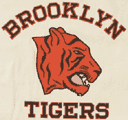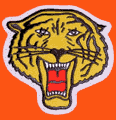Related Research Articles

The Rock Island Independents were a professional American football team, based in Rock Island, Illinois, from 1907 to 1926. The Independents were a founding National Football League franchise. They hosted what has been retrospectively designated the first National Football League game on September 26, 1920 at Douglas Park. The Independents were founded in 1907 by Demetrius Clements as an independent football club. Hence, the team was named the "Independents."

The Brooklyn Dodgers were an American football team that played in the National Football League from 1930 to 1943, and in 1944 as the Brooklyn Tigers. The team played its home games at Ebbets Field of the baseball National League's team, the Brooklyn Dodgers. In 1945, because of financial difficulties and the increasing scarcity of major league-level players because of the war-time defense requirements at the height of World War II, the team was merged with the Boston Yanks and were known as the Yanks for that season.
The first American Football League (AFL), sometimes called AFL I, AFLG, or the Grange League, was a professional American football league that operated in 1926. It was the first major competitor to the National Football League (NFL). Founded by Charles "C.C." Pyle, (1882–1939), and General Charles X. Zimmerman, (1865–1926), as vice president and starring Hall of Fame halfback Harold Edward "Red" Grange, (1903–1991), the short-lived league with nine teams competed against the more established – then six-year-old – NFL, both for players and for fans. While Pyle's and Grange's New York Yankees team and the already established Philadelphia Quakers became reliable draws, the lack of star power and the uncertain financial conditions of the other seven teams led to the league's dissolution after one season.
The American Football League, also known retrospectively as the AFL III to distinguish it from earlier organizations of that name, was a professional American football league that operated from 1940–1941. It was created when three teams, the original Cincinnati Bengals, the Columbus Bullies, and the Milwaukee Chiefs, were lured away from the minor-league American Professional Football Association and joined three new franchises in Boston, Buffalo, and New York City in a new league. It competed against the National Football League (NFL), the oldest existing professional football league, established 1920 and reorganized 1922.
The American Football League (AFL) was a professional American football league that operated in 1936 and 1937. The AFL operated in direct competition with the more established National Football League (NFL) throughout its existence. While the American media generally ignored its operation, this second AFL was the first "home" of the Cleveland Rams, which joined the National Football League after one year in the AFL.
The Midwest Football League (MFL) was a professional american football minor league that existed from 1935 to 1940. Originally comprising teams from Ohio, Kentucky, Indiana, and Illinois, the league eventually expanded its reach to include teams from Missouri, Tennessee, Wisconsin, and California to become a national league with major league aspirations by 1939. In 1938, the league became the American Professional Football League after the collapse of the second major league of the same name, but changed its name once again the following year to American Professional Football Association (APFA). Some sources refer to it as the American Professional Football League.
The Columbus Bullies were a professional football team founded by Phil H. Bucklew in Columbus, Ohio in 1938. The Bullies started out as a member of the American Professional Football Association (APFA) in 1939. Later, in 1940, the Bullies joined the Cincinnati Bengals and Milwaukee Chiefs in leaving the APFA and becoming charter members of a new American Football League. Playing in Red Bird Stadium, the Bullies won both AFL Championships prior to ceasing operations when the AFL disbanded due to World War II. The Bullies defeated the Milwaukee Chiefs in 1940, and the New York Americans in 1941 in the only two AFL Championships.
The 1936 AFL season is the first season of the second American Football League, the formation of which was announced by Harry March, former personnel director of the NFL's New York Giants, on December 15, 1935. Fifteen cities bid for charter franchises; on April 11, 1936, franchises were awarded to eight cities: Boston, Cleveland, Jersey City, New York, Philadelphia, Pittsburgh, Providence, and Syracuse. By mid-summer, Jersey City, Philadelphia, and Providence withdrew; soon afterwards, Rochester was given a franchise, only to have it relocated to Brooklyn, despite the lack of availability of a home stadium at the time.
The 1937 AFL season is the second and final season of the second American Football League. After the folding of the Syracuse/Rochester Braves in the 1936 season and the departure of the Cleveland Rams for the National Football League, the league added the Cincinnati Bengals and the Los Angeles Bulldogs, the latter being the first professional football team to play its home games on the American West Coast.

The Los Angeles Bulldogs were a professional American football team that competed from 1936 to 1948. Formed with the intention of joining the National Football League in 1937, the Bulldogs were the first team on the major league level to play its home games on the American West Coast. They were considered "the best football team in existence outside the NFL".
The American Association (AA) was a professional American football minor league based in New York City. Founded in 1936 with teams in New York and New Jersey, the AA extended its reach to Providence, Rhode Island prior to the onset of World War II. After a four-year hiatus, the league was renamed the American Football League as it expanded to include teams in Ohio and Pennsylvania. In 1947, the Richmond Rebels of the Dixie League purchased the assets of the defunct AFL Long Island Indians and jumped leagues.
The 1941 AFL season was the second and final season of the third American Football League. After deeming the 1940 season to be a success, the league made overtures of expansion, even going to the point of having a press conference to announce the addition of new teams (July), but when the press conference was held, the Boston Bears had withdrawn from the league and the new Detroit franchise deferred entry for the 1942 season.
The 1940 AFL season was the first season of the third American Football League. The league was formed when the New York Yankees, Boston Bears, and Buffalo Indians were joined by the Cincinnati Bengals, Columbus Bullies, and Milwaukee Chiefs of the minor American Professional Football Association. After the announcement of the formation of the AFL, applications for membership by former APFA members St. Louis Gunners and Kenosha Cardinals were rejected by the upstart league, which started with six members.
The Chicago Bulls were a professional American football team that competed in the first American Football League in 1926. Owned by Joey Sternaman, the Bulls also had AFL founders C. C. Pyle and Red Grange as shareholders. Joey Sternaman was also the coach and blocking back for the Bulls throughout their brief existence.
The Buffalo Indians were a professional American football team that competed in the third American Football League in 1940 and in 1941. The team played its home games in Civic Stadium in Buffalo, New York. Owned by the Buffalo American Legion, the Indians were managed by Earl "Red" Seick, who was also player-coach for the team for the first five games in 1940. While most of the AFL membership focused on raiding the rosters of the local members of the National Football League teams, the Indians concentrated on signing local talent, castoffs from the NFL, and men who played in the defunct second American Football League.
The Milwaukee Chiefs were a professional American football team based in Wisconsin that competed in the third American Football League in 1940 and in 1941.
The Boston Bears were a professional American football team that competed in the third American Football League in 1940. Owned by Sheldon H. Fairbanks, the team played its home games in the Fenway Park in Boston, Massachusetts. Coach Eddie Casey’s team was a competitive one, finishing the 1940 season with a 5-4-1 record, good for third place in the AFL, behind league champions Columbus Bullies and second-place Milwaukee Chiefs.

The Rochester Tigers were a professional American football team that competed in the second American Football League in 1936 and 1937. Owned by Mike Palm and Harry Newman, the Tigers were originally awarded to Rochester as a charter member of the AFL, but were shifted to Brooklyn two weeks afterward despite the lack of availability of a home stadium in its new home town, then moved back to Rochester midway through the 1936 season.
The Louisville Tanks were a minor league professional American football team that existed from 1935 to 1940. The team formed in the wake of the dissolution of the Louisville Bourbons of the short-lived American Football League of 1934. Organized and owned by American Standard, Inc., the team was coached by AS plant manager H.M. "Harry" Reed; its name and colors come from one of the products sold by American Standard. The Tanks played their home games at Parkway Field in Louisville, Kentucky, USA.
The New York Yankees of the second American Football League was the second professional American football team competing under that name. It is unrelated to the Yankees of the first AFL, the Yankees of the third AFL, the Yankees of the American Association and the (later) Yankees of the All-America Football Conference. The Yankees played their home games in Yankee Stadium and Triborough Stadium in New York, New York. Jack McBride was the team’s head coach throughout its existence; Yankees' president James Bush served as president of the second American Football League in 1936.
References
- ↑ George Gipe, The Great American Sports Book (Doubleday 1978) ISBN 0-385-13091-0
- ↑ David L. Porter, editor, ‘’Biographical Dictionary of American Sports: Football’’ (Greenwood Press 1987)
- ↑ George Gipe, The Great American Sports Book (Doubleday 1978) ISBN 0-385-13091-0
- ↑ Nothing Minor About It: The American Association/AFL of 1936-50 Archived March 26, 2012, at the Wayback Machine – Bob Gill, Professional Football Researchers Association (1990)